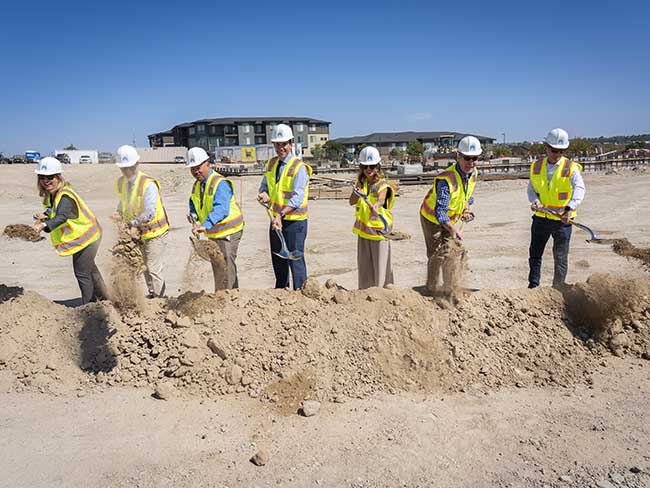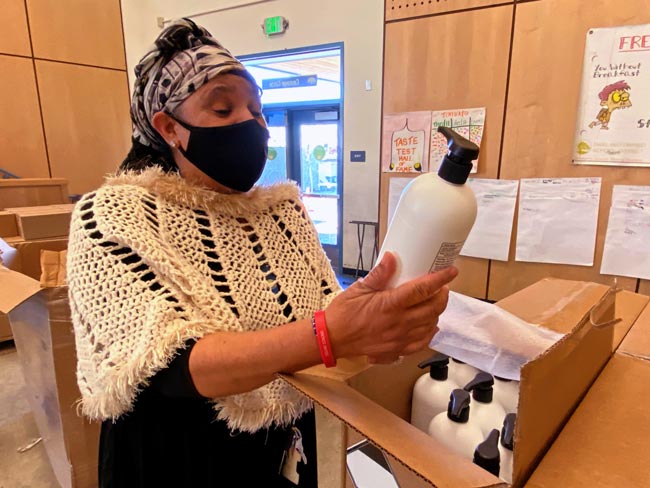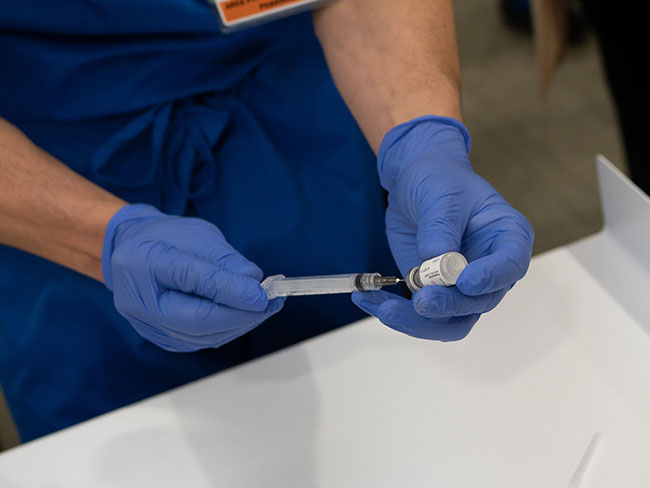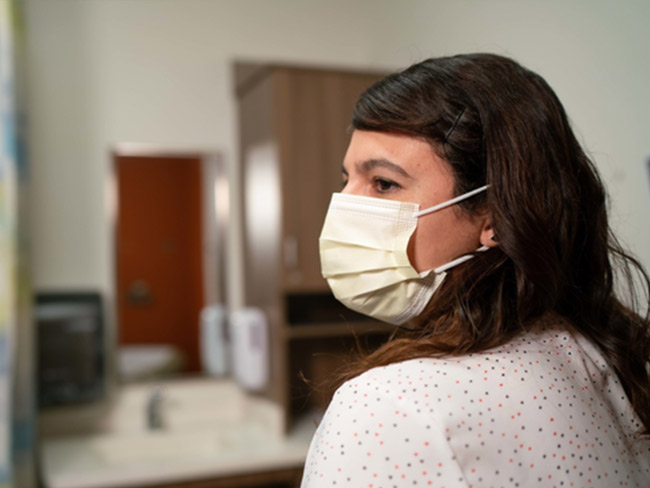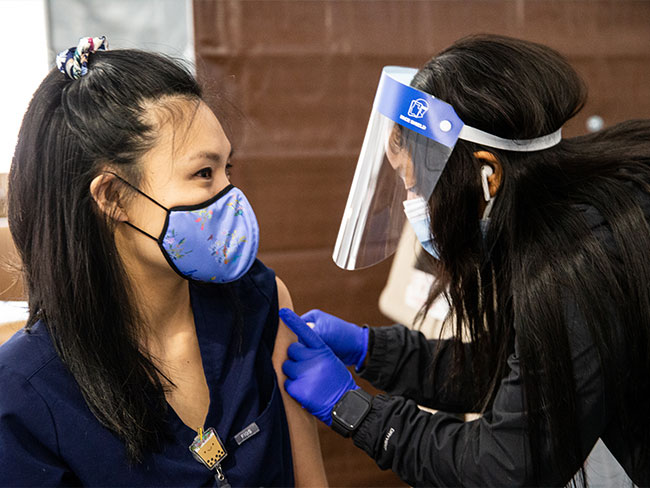Analysis confirms racial disparities in COVID-19 infection
Kaiser Permanente study examines race, ethnicity and risk of infection, hospitalization, and death.
PRESS RELEASE
Contacts: Jan Greene
janice.x.greene@kp.org
510-504-2663
Kerry Sinclair
ksinclair@webershandwick.com
310-854-8278
OAKLAND, Calif. — An analysis of Kaiser Permanente members in Northern California early in the COVID-19 pandemic found racial and ethnic disparities in the likelihood of testing positive for the coronavirus, but no significant disparities in mortality among those who were hospitalized.
According to the study published Feb. 8 in Annals of Internal Medicine, Latino patients were nearly 4 times as likely as white patients to become infected with the virus, while Asian and Black patients were 2 times as likely to get COVID-19 as white patients. The odds of hospitalization were also higher for Latino, Asian, and Black patients with COVID-19 than for white patients. However, the study did not find racial disparities in mortality among patients hospitalized after infection.
The authors of the study said the findings reinforce the urgent message to health systems to mitigate the spread of COVID-19 in their highest-risk communities by seeking to reduce transmission among the most vulnerable.
“We need to continue to explore the reasons why some communities have higher infection rates, which in a pandemic can be deadly,” said lead author Gabriel Escobar, MD, an investigator with the Kaiser Permanente Northern California Division of Research. “It’s also our responsibility as clinicians and health care leaders to improve the way we reach out to these communities.”
While research from other health systems has also found racial disparities related to COVID-19, this analysis was the first to follow a cohort of patients from virus testing through the complete course of the disease, the authors said.
“COVID-19 has dramatically altered the patterns of health care delivery across the world making it more difficult than ever to trace patients’ experiences and outcomes,” said coauthor Vincent Liu, MD, MS, a research scientist with the Northern California Division of Research and critical care specialist with The Permanente Medical Group. “Kaiser Permanente’s comprehensive health data from testing to medical care and hospitalization allow us to carefully assess the impact of racial and ethnic differences at each stage.”
The study examined a total of 3.5 million Kaiser Permanente members in Northern California, 2.6% of whom, or 91,212 people, received a COVID-19 test between Feb. 1 and May 31, 2020. Of the total, 4%, or 3,686, tested positive.
The study confirmed other research linking specific comorbidities with increased mortality from COVID-19, and that nonwhite patients were more likely to have chronic health conditions. However, the authors noted that there are complex reasons why that might be. “Many factors may contribute to comorbidity and intrinsic risk, including the totality of ways in which societies foster racial discrimination, through mutually reinforcing inequitable systems (structural racism),” they wrote.
Unadjusted hospital mortality rates were highest among white patients (17%), followed by Black patients (12.7%), Asian patients (10.5%), and Hispanic patients (9.7%). After adjusting for age, severity of illness, and comorbidities, racial and ethnic differences were no longer significantly different.
Neighborhood and age as risk factors
Along with following the outcomes for those who tested positive, the analysis also looked at the role of geographic location, finding infections clustered in areas with higher proportions of nonwhite members, regardless of their health risks for COVID-19.
The researchers found race was a major factor in likelihood of infection, but contributed in a minor way to hospitalization, admission, and death. For those adverse outcomes, age was the major predictor.
The findings bring an important message to health care leaders, said coauthor Stephen Parodi, MD, associate executive director of The Permanente Medical Group and national infectious disease leader at Kaiser Permanente. “Health care systems are in a position to take action in their communities in response to these inequities,” Dr. Parodi said. “Specifically, we must continue to pursue initiatives such as community education, contact tracing, and public health partnerships. We are deepening community connections to address social determinants in response to an unprecedented health threat that is taking an unequal toll.”
Clinicians also have a role in reducing inequities, and Kaiser Permanente has taken steps to support clinicians in doing so, said coauthor Yi-Fen “Irene” Chen, MD, associate executive director of The Permanente Medical Group. “The pandemic has moved many medical visits to telehealth, which has many benefits, but we must remain aware of the digital divide that could make this technology harder to access in some traditionally underrepresented communities,” Dr. Chen said. “Addressing such issues is part of Kaiser Permanente’s longstanding commitment to health equity.”
Dr. Chen noted the importance of addressing equity in vaccination. “Now that COVID-19 vaccines are available, physicians and health care providers must employ culturally tailored messaging for communities that experience health disparities, to make sure they are optimally informed and protected,” she said.
Funding for the research came from The Permanente Medical Group.
Coauthors also included former Division of Research investigator Alyce S. Adams, PhD, now with Stanford University; Catherine Lee, PhD, Lauren Soltesz, MS, G. Thomas Ray, MBA, and Laura C. Myers, MD, MPH, of the Division of Research; Charulata M. Ramaprasad, MD, MPH, of Kaiser Permanente San Jose Medical Center; and Richard Dlott, MD, of Kaiser Permanente Martinez Medical Offices.
About Kaiser Permanente
Kaiser Permanente is committed to helping shape the future of health care. We are recognized as one of America’s leading health care providers and not-for-profit health plans. Founded in 1945, Kaiser Permanente has a mission to provide high-quality, affordable health care services and to improve the health of our members and the communities we serve. We currently serve 12.4 million members in 8 states and the District of Columbia. Care for members and patients is focused on their total health and guided by their personal Permanente Medical Group physicians, specialists, and team of caregivers. Our expert and caring medical teams are empowered and supported by industry-leading technology advances and tools for health promotion, disease prevention, state-of-the-art care delivery, and world-class chronic disease management. Kaiser Permanente is dedicated to care innovations, clinical research, health education, and the support of community health.











